

The shape and style of the armorial shield
by
Mike Oettle
African shields
NO one style of shield has prevailed in the history of armory, just as no one shield shape is universal among traditionally non-armorial cultures.
However, there are three broad categories into which shields fall.
Firstly there is the broad Western tradition of armory, within which the so-called heater shield (known on the European Continent as early Gothic) predominated in its early phases, and has enjoyed a revival in the 20th and 21st centuries.
Secondly, within the Western tradition there are particular shield styles which have prevailed in certain regions or during certain periods. The use of some of these may still be justified today on the grounds of ethnic usage or appropriateness to a particular period, although in broad terms the heater is still the ideal
And lastly there is a range of shields traditionally used in non-armorial societies which have, especially in recent years, had some armorial application.
To the broad tradition two categories of exception must be noted, however: the arms of clergy, and the arms of women.
The
Western tradition:
Before the emergence of armorial or heraldic usage in Western Europe, a number of different styles were used.
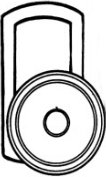
The Roman armies essentially used two styles, one circular – known in English as the targe – and one largely rectangular, but rounded at the top and bottom. This rectangular style was used by the majority of the infantry during much of the life of the Roman Empire in the West.

The targe was also used in other societies, and is especially associated with the Norsemen who raided and later settled the coasts of the European mainland and the British Isles.
It seems that the rounded rectangle shape continued in use in Spain, or perhaps enjoyed a revival in the period when heraldic usage was introduced in that country, as many early Spanish coats of arms fit best in that type of shield.
As is outlined in this article, heraldry as we know it first emerged in Flanders around the 9th century AD and was carried into other parts of Europe by Flemish families.
Flemings made up a significant element in William of Normandy’s army of 1066 which occupied England. The Bayeux Tapestry illustrates William’s knights carrying long, pointed shields with rounded tops – these Norman shields carry devices which do not appear to have been armorial (or at any rate hereditary) in nature, but this may simply be due to ignorance on the part of the ladies who produced the tapestry in the cathedral cloister at Bayeux.
It seems that the heater was arrived at by taking the long Norman shield, slicing its rounded top off, and shortening it.
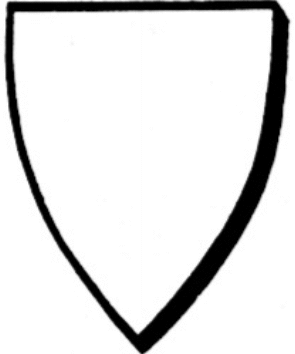
The big Oxford English Dictionary simply states that the classic shield shape – generally in use around AD 1200 – is called “heater” because it has the shape of a heater.[1] Nowadays this shape (a triangle rounded outwards on its longer sides) is associated with the hot plate of the pressing-iron, but when we talk of shields, the name heater is still used.
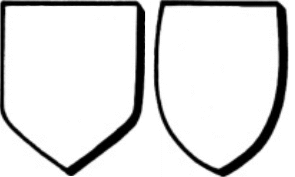
Other styles developed in due course, but during the classic[2] period of heraldry they retained the flat top and pointed base of the heater.
Allcock[3] notes that the shield generally fell out of use in warfare around 1360 following the introduction of the crossbow, which largely rendered it useless in defence.
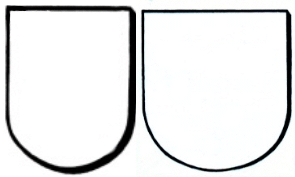
It continued in use in the tournament, but in styles that became increasingly impractical. This becomes clear in those designs featuring a rounded base – in earlier times a shield had to have a point in base for practical reasons of warfare. (These later styles are known on the Continent as late Gothic.)
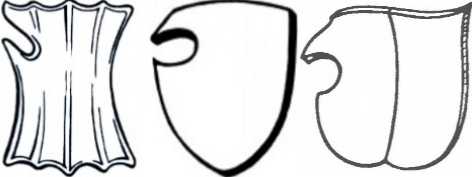
A feature that begins to be found around 1400 is the lance rest – a notch in the upper dexter corner which allowed the knight to slot his lance into the shield during the mounted charge. This was eminently practical in the tilting yard, but counterproductive on the battlefield.
Both Slater[4] and Allcock show a variety with scalloped top and bottom edges and a lance rest. Next to it is one with a horizontal notch, and lastly one with an inverse notch, from which any lance would fall out immediately. François Velde calls this last version a “targe”, but this seems wrong in English.
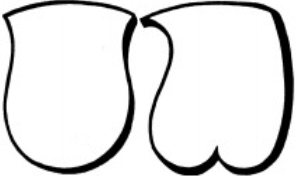
In the tournament, the mounted knight was required first to charge against his opponent on horseback, his lance positioned to unseat the other man. If unhorsed, the knights were then required to fight on foot, using hand weapons – principally the sword, but in some instances battle-axes, maces, war-hammers, or spiked-ball-and-chain combinations.
And as the shield became more a device used in artwork and decoration, rather than a defensive weapon, even the lance rest degenerated – Allcock shows one with an almost horizontal notch, and in later centuries shields were drawn with lance rests pointing downwards, from which any lance would fall out immediately.

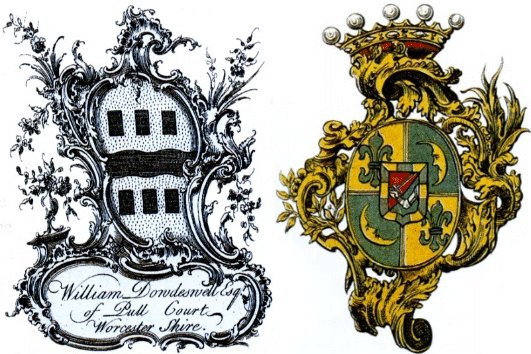
It is hardly surprising that a progressive degeneration can be seen in the styles that follow – especially in those from 500 to 300 years ago which clearly show the influence of the baroque and rococo styles of artistic decoration. In these the shield itself has a very poorly defined form, and is principally a means for allowing the artist to add as much elaborate scrollwork (frequently gilded) as possible.
It can be seen clearly that these shields were not only never intended to be carried in war, but in all probability were regarded purely as abstract decoration, either in a book or in architectural tat.
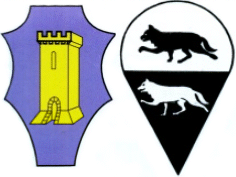
Slater also shows two examples of shields common in Italian heraldry. The first is derived from the armour placed over a horse’s face – with scoops on either side allowing the animal to see clearly in the battlefield, and terminating at the beast’s nostrils – while the other follows more of a teardrop shape. (He does not say whose arms are illustrated here.)

A variety of odd shapes emerge from this period, including one that is almost rectangular, with a rounding on either side at the base and a base point in the middle. It may have first appeared around 1500, but it was widely used in the 19th century, as were several other equally impractical forms. In some circles this is called a French shield.

Of those shown here (at left), the first is unfamiliar to me, but the other three make a strong showing, even in the 21st century, in South African coats of arms that have not been through the Bureau of Heraldry (and a few which have in fact been registered). The second (the arms of the Oranje Vrij Staat) is known as a Renaissance shield, and the last an “English” shield (the arms of Wynberg). The one in between is typical of the 18th and 19th centuries and is the arms of Sir Benjamin d’Urban.
Several varieties are known of both the oval cartouche (used in the arms of priests, and often of ladies, but notably also in the arms of the Zuid Afrikaansche Republiek and the Transvaal Province) and the “diamond”-shaped lozenge, used exclusively for ladies, as explained here.
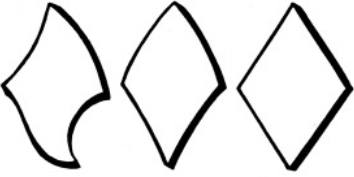
Three types of lozenge are shown at left.

Having outlined these styles, the question still needs to be asked: which is preferable? The simple answer is: in most cases, the heater or something close to it.
However an exception must be made in the case of a quarterly shield, or in a coat of arms which has a considerable amount of detail in the base. In instances like this, the broad near-rectangular shield is permissible.
The broad shield is, however, entirely unsuitable when the coat of arms in question is of a simple design, bearing only one charge or just a few. Since the artistic use of space in the heraldic tradition requires that the charge or charges fill out the shield, it is ludicrous to show, for argument’s sake, a solitary lion spreading itself to fill the entire rectangle.
Degenerate Victorian heraldic art will often show a minute lion, badly drawn but vaguely attempting to be “naturalistic” as opposed to armorial, occupying perhaps a sixth or a fifth of the shield area.
There is usually no reason whatever for using an elaborate shield from any of the periods following the close of the Middle Ages.
I can think of only one exception, to be found in the arms of Bermuda, and even then the arms are not shown within the elaborate shield; rather, the elaborate shield is a charge, a small part of the whole.
This is justified by the herald’s intention in composing the device. It is a symbolic representation of the period in which Bermuda was first settled. The arms show a lion sejant affronty holding a baroque shield upon which is depicted the wrecked ship from which the first settlers managed to escape alive. The shape of the shield held by the lion is one that was in general use at the time of the shipwreck.
Outside the Western tradition:
While armory originated in Western Europe and is even today principally a Western style of identification and display, heralds in the 20th century, especially, have attempted to make coats of arms more relevant to communities in countries outside Europe by adopting shield shapes commonly used in those societies.
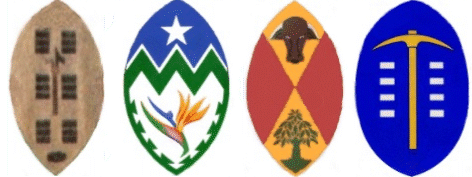
This is seen principally in African heraldry – originally in grants to newly independent countries by the College of Arms, but more especially in arms registered by the Bureau of Heraldry in Pretoria.
Unfortunately the heralds went ahead rashly and devised arms using shield shapes that were not always appropriate.
Most widely used is the Nguni shield, so called because it is based on the traditional shield of the abaNguni, and principally from among that subgroup of the Bantu-speaking peoples, the amaZulu of South Africa.
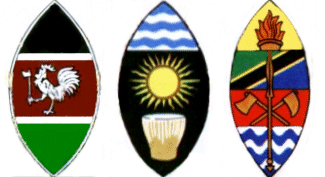
Similarly shaped shields also occur among other Bantu-speaking peoples, so it is not inappropriate that the arms of Kenya, Uganda and Tanzania all appear with Nguni shields.
Within South Africa, the arms of KwaZulu, its successor KwaZulu-Natal, Ciskei and Gauteng have Nguni shields, while two Swazi-speaking states, the Kingdom of Swaziland and the former Bantustan state of KaNgwane show the more rounded shields of this grouping.

Curiously, however, the Swazi shield used by Swaziland is not the shield of the arms – this is a heater shape – but a charge within that shield. And in the case of KaNgwane the shield is so rounded that it only vaguely shows a point at the bottom end.
The amaNdebele (another Nguni grouping) of what is now Mpumalanga followed a different tradition: the Bantustan state of KwaNdebele has a circular shield (as noted above, this shape is known in Britain as a targe).
The Tsonga people are found largely in southern Moçambique but also, a smaller population, in Mpumalanga. There they had the Bantustan of Gazankulu, the arms of which had yet another shape – an extended oval.
Also occurring within Southern Africa is the Sotho-speaking group, which has two similar but distinct shield shapes.

The South Sotho, or Basotho ba Borwa, use a shield with rounded sideways projections near the top and also at the base on each side. This can be found in the arms of the Kingdom of Lesotho.
The Batswana, or West Sotho, use a shield with similar projections, but with a more angular appearance. This is found in the arms of the Bantustan state of Bophuthatswana, and curiously also in the arms of the South Sotho Bantustan of Qwaqwa. However, the Republic of Botswana – entirely inappropriately – uses a Nguni shield.
The North Sotho, or Basotho ba Leboa, did not display an African shield in the arms of the Bantustan state of Lebowa – this, sadly, is a squat European shield.
European shields are also found in the arms of Zimbabwe, its predecessor Rhodesia, Namibia, Zambia, Malawi, Congo-Kinshasa, Burundi, Somalia, Nigeria, Senegal, Sierra Leone, Ivory Coast, Dahomey (now called Benin), Gabon, The Gambia, Ghana, Chad, Equatorial Guinea and the islands of Mauritius, Réunion and Mayotte.
The Western tradition is also observed in the degenerate and vaguely armorial devices of Liberia, the previous arms of Rwanda, Cameroon, Guinea, Burkina Faso, Togo, Niger, the Central African Republic and South Africa (in the “arms” adopted in 2000).
Yet another tradition comes into play in northern Africa,[5] one going back to mediæval interactions between Crusaders and Muslims, where state devices use a shield shape of sorts, but fall within usages of Islamic culture which are not dictated by Western traditions of armory.
Devices of this kind are found in the arms of the Kingdom of Morocco, the Arab Republic of Egypt, Tunisia and Sudan.
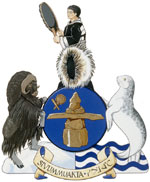
Outside Africa, there have been exciting developments in armory, notably in Canada, where the Canadian Heraldic Authority has made full use of its independence from the College of Arms to develop a strongly indigenous symbolism, not only for arms within the Western tradition, but especially in the devices of native peoples.
The round shield of the Inuit [6] people has appeared in several grants made in Ottawa, notably in the arms of the territory of Nunavut. Shown here are the arms of Peter Irniq, of Iqaluit in Nunavut.
